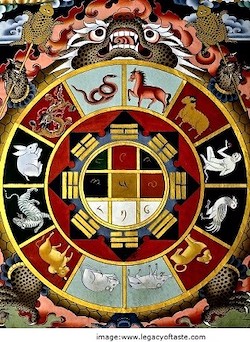 The Bhutanese calendar is based on the Tibetan which in turn derives from the Chinese lunar system. In the seventeenth century, the scholar Pema Karpo introduced into Bhutan a new method for computing the days of the week. From this, a number of differences from the Tibetan model have arisen. The method of accounting for a leap year differs for example and auspicious periods during the year are not always the same.
The Bhutanese calendar is based on the Tibetan which in turn derives from the Chinese lunar system. In the seventeenth century, the scholar Pema Karpo introduced into Bhutan a new method for computing the days of the week. From this, a number of differences from the Tibetan model have arisen. The method of accounting for a leap year differs for example and auspicious periods during the year are not always the same.
Each cycle consists of sixty years, with each year named after a predetermined combination of elements and animals. Each month has thirty days of which the 8th, 15th (full moon) and last are held to be auspicious. Especially the favourable periods during the year include the summer and winter solstices, the fourth day of the sixth month when Buddha first preached his religious principles and Lhabab Duchhen when he returned to earth from the thirty-seven heaven.